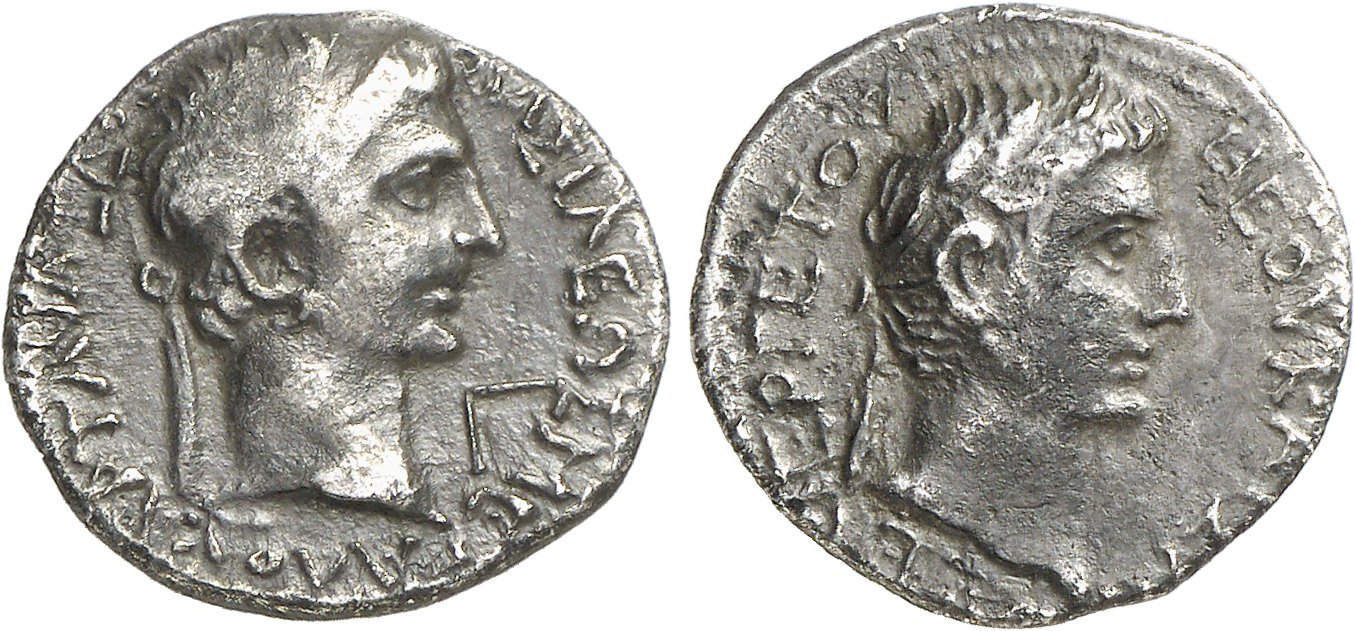Artaxata? (Artavasdes IV), silver, drachms (4-6 CE)
From SILVER
4 CE - 6 CE Silver 424 kg
Description
| ObverseInscription or printing placed on the obverse.: | ΒΑΣΙΛΕΩΣ MEΓΑΛΟΥ APTAYAΣΔOY (Greek).Head of the king Artavasdes to right, wearing a diadem.In the right field, Γ. Border of dots. |
| ReverseInscription or printing placed on the reverse.: | ΘΕΟΥ ΚΑ(IΣΑΡΟΣ) EYEPΓETOY (Greek).Head of Augustus to right, wearing alaurel wreath. Border of dots. |
Mint and issuing power
| MintIdentifies the place of manufacture or issue of a numismatic object.: | Artaxata | Ancient regionAncient region.: | Armenia | Modern countryModern country: Armenia | AuthorityIdentifies the issuing power. The authority can be "pretended" when the name or the portrait of X is on the coin but he/she was not the issuing power. It can also be "uncertain" when there is no mention of X on the coin but he/she was the issuing power according to the historical sources: | Artavasdes IV of Armenia (Artaxiad king, 4-6), Augustus (Roman emperor, 27 BC-14 AD), Armenian kingdom |
Chronology
| FromIdentifies the initial date in a range assigned in a numismatic context. | 4 CE | toIdentifies the final date in a range assigned in a numismatic context.. | 6 CE | PeriodTime period of the numismatic object.: Roman from 30 BC |
Physical description
| MetalThe physical material (usually metal) from which an object is made.: | Silver |
Median weightMedian of the weights of numismatic objects (in grams). in grams | 3.50 | DenominationTerm indicating the value of a numismatic object. Examples: tetradrachm, chalkous, denarius.: | drachma |
StandardStandard.: | Attic |
Image

S103 Artaxata Artavasdes III drachms.jpg [1]
References
| Die study referencePublication of the study: | Nercessian 20061Nercessian 2006, p. 114-115 | ||
| Coin series referenceReference to coin series study: | RPC I2RPC I, n° 3843 | ||
| Coin series web referenceCoin series web references: | |||
Obverse dies distribution
| FrequencyFrequency of specimen in distribution. ᵖ | Number of obversesNumber of obverse dies. ᵖ (o) | % (o) | Number of coinsNumber of coins. (n) | % (n) | Die nameName(s) of the die(s). |
| 1 | 2 | 66.67 | 2 | 40 | 2, 3 |
| 3 | 1 | 33.33 | 3 | 60 | 1 |
| Total | 3 of 3 | 100 | 5 of 5 | 100 |
Reverse dies distribution
no distribution is available
Quantification
| Number of obversesNumber of obverse dies. ᵖ (o) | 3 | Number of singletons (o1)The number of singleton coins. ᵖ | 2 |
| Number of reverse diesNumber of reverse dies. (r) | 3 | Number of coinsNumber of coins. (n) | 5 |
| Coins per obverse dieNumber of coins per obverse die. (n/o) | 1.67 | Coins per reverse dieNumber of coins per reverse die. (n/r) | 1.67 |
| Reverse per obverse ratioRatio of obverse dies divided by reverse dies. (r/o) | 1 | Percentage of singletons (o1)number of coins (n) divided by the number of singletons (o1) ᵖ | 66.67 % |
| Original number of dies (O) (Carter 1983 formula)The estimation of the number of coins according to Carter 1983 ᵖ | 6.05 | Coins struck if 20,000 as average productivity per dieCoins made if the average productivity for obverses (according to Carter) is 20,000. ᵖ | 121,000 |
| Original number of dies (O) (Esty 2011 formula)The estimation of the number of coins according to the singleton formula in Esty 2011 ᵖ (O) | 7.5 | Survival rate if 20,000 as average productivity per dieSurvival rate if average productivity is 20,000. ᵖ | 0.00004 |
| Coverage (o = % of O) (Esty 1984 formula)Esty 1984 - coverage (% of O) ᵖ (o = % of O) | 60% | Die productivity if survival rate 1/2,000Average productivity if survival rate is 1/2,000. ᵖ | 1,652.89 |
| Weight of silver (in kg) if 20,000 coins per die (O = Carter formula)Carter 1983 * Median weight * 20000 (*10 if gold or electrum) ᵖ | 424 kg <br /> 424 kg | Die productivity if survival rate 1/5,000Average productivity if survival rate is 1/5,000. ᵖ | 4,132.23 |
Remarks
Most likely one single workstation